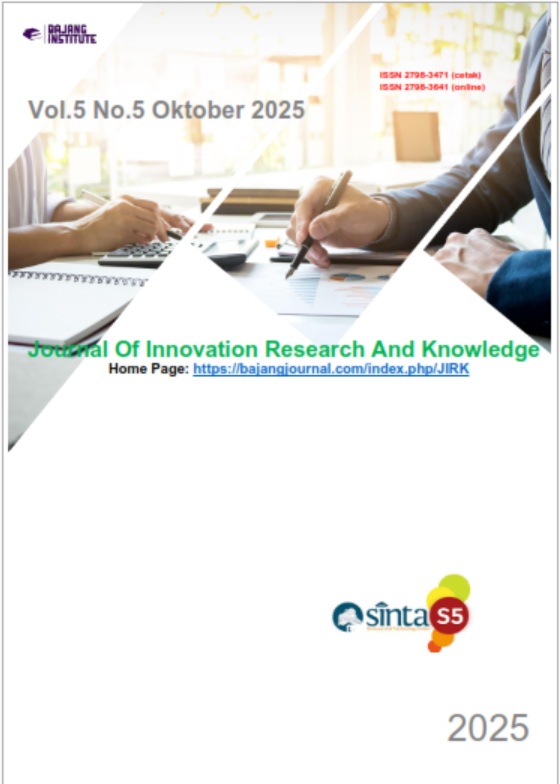AUTHENTICITY OF FLAVOR IN JAPANESE CUISINE AT ICHIRIN RAMEN PENUIN BATAM
Keywords:
Authenticity, Taste, Japanese Restaurants, Cooking TechniqueAbstract
The increase of Japanese restaurants in Indonesia has raised questions about how to identify which restaurant that serve authentic taste of Japan, while many adapted to local preferences. This research purpose is to analyze the concept of authenticity in the context of operating a Japanese restaurants in Indonesia, along with the factors that made a Japanese restaurants being considered authentic in terms of taste. This research uses Ichirin Ramen Penuin Batam as a case study. This research is using qualitative method to analyze data, gathered through interviews with chefs and customers, direct observations of the food preparation process and the restaurants atmosphere. The results show how Ichirin Ramen Penuin Batam preserves authenticity through constructed balance between tradition and adaptation. Customers perceive authenticity not only through taste but also through presentation, service, and atmosphere, indicating that authenticity is a holistic experience rather than a fixed standard. The study highlights that Japanese restaurants abroad can sustain cultural credibility by balancing tradition at Batam.
References
Afifi, Mohamed Fawzi, J. J. Healy, and Máirtín Mac Con Iomaire. “Chefs’ Perspectives of Failures in Foodservice Kitchens, Part 2: A Phenomenological Exploration of the Consequences and Handling of Food Production Failure.” Journal of Foodservice Business Research 26, no. 5 (2023): 669–99. https://doi.org/10.1080/15378020.2022.2044736.
Akon, MD. Saifullah, and Debasish Nandy. “Japanese Culinary Industry in South Asia: An Exploratory Comparison of Indian and Bangladeshi Consumers.” The Journal of Indian and Asian Studies 05, no. 01 (2024). https://doi.org/10.1142/s2717541324500013.
Ali, Umar Farouq, and Vasco Santos. “Glocalization Strategies in the Food Industry: Adapting to Local Needs and Demands.” Evolving Strategies for Organizational Management and Performance Evaluation, 2025, 237–62. https://doi.org/10.4018/979-8-3373-0149-5.ch012.
Alpi, Kristine M., and John Jamal Evans. “Distinguishing Case Study as a Research Method from Case Reports as a Publication Type.” Journal of the Medical Library Association 107, no. 1 (2019): 1–5. https://doi.org/10.5195/jmla.2019.615.
Balázs Kovács, Glenn R. Carroll, David W. Lehman. “Authenticity and Consumer Value Ratings: Empirical Tests from the Restaurant Domain,” 2013, 1–41.
Boyle, Dominick. “‘ Authentic and Amazing ’: Authenticity as an Evaluative Category in Online Consumer Restaurant Reviews The Role of Authenticity in Food Discourse : Distinction” 7, no. 2 (2024): 1–25.
Domon, Koji, Alessandro Melcarne, and Giovanni B. Ramello. “Fake & Original: The Case of Japanese Food in Southeast Asian Countries.” European Journal of Law and Economics 54, no. 2 (2022): 327–47. https://doi.org/10.1007/s10657-022-09742-9.
Farrer, James, Chuanfei Wang, David Wank, Mônica R. de Carvalho, Christian Hess, and Lenka Vyletalova. “Japanese Culinary Mobilities Research: The Globalization of the Japanese Restaurant.” Foods & Food Ingredients J. Jpn. 222, no. 3 (2017).
Hariani, Dina. “Halal Japanese Culinary as Attraction for Muslim Travellers to Visit Japan” 28, no. Ictgtd 2016 (2017): 174–76. https://doi.org/10.2991/ictgtd-16.2017.32.
Hartati, Yulia, and Ayu Meiliana. “Gambaran Spesifikasi Bahan Makanan Segar Dan Citarasa Makanan Lunak Yang Dihasilkan.” Jurnal Pustaka Pada 1, no. 1 (2022): 11–16.
Khasanah, Umul, Sidrotun Naim, Wahyuning Dyah, Negeri Madiun, and Politeknik Negeri Bali. “Japanese Diplomatic Strategy in Using Traditional Culinary as An Instrument of Cultural Diplomacy in Indonesia.” Jurnal Kewarganegaraan 7, no. 1 (2023): 1161–67. http://journal.upy.ac.id/index.php/pkn/article/view/5225.
Kim, Sangkyun, Eerang Park, and Min Xu. “Beyond the Authentic Taste: The Tourist Experience at a Food Museum Restaurant.” Tourism Management Perspectives 36, no. April (2020): 100749. https://doi.org/10.1016/j.tmp.2020.100749.
Kiráľová, Alžbeta, and Lukáš Malec. “Local Food as a Tool of Tourism Development in Regions.” International Journal of Tourism and Hospitality Management in the Digital Age 5, no. 1 (2021): 54–68. https://doi.org/10.4018/ijthmda.20210101.oa1.
Kumar, Vinod, and Ruchika Kulshrestha. “Changing Tastes: How Globalization Is Shaping Regional Cuisines-Culinary Innovation and Fusion Cuisine, Variety, and Availability of Ingredients.” Global Sustainable Practices in Gastronomic Tourism, 2024, 231–41. https://doi.org/10.4018/979-8-3693-7096-4.ch013.
Mitchell, Eleanor. “A Qualitative Approach on the Impact of Globalization on Traditional Italian Restaurant Supply Chains A Qualitative Approach on The Impact of Globalization on Traditional Italian Restaurant Supply Chains,” 2025, 0–16. https://doi.org/10.20944/preprints202501.0015.v1.
Ningsih, Siti Ayu, Ni Luh, Gede Meilantari, and Betty Aritonang. “Adaptasi Masakan Jepang Di Indonesia Pada Restoran Franchise Marugame Udon Dan Hakata Ikkousha Di Bali.” Jurnal Daruma: Linguistik, Ssatra Dan Budaya Jepang 1, no. 1 (2021): 105–18.
Pangestu, Almyra Diah, and Siti Gomo Attas. “Fenomena Restoran Jepang Halal: Perspektif Agama Dan Ekonomi.” Community Development Journal : Jurnal Pengabdian Masyarakat 3, no. 3 (2022): 1892–99. https://doi.org/10.31004/cdj.v3i3.9339.
Permata, Gilang, Gilang Permata Manajemen Bisnis Syariah, Uin Sayyid Ali Rahmatullah Tulungagung, and Muhammad Alhada Fuadilah Habib Manajemen Bisnis Syariah. “Pengaruh Kualitas Pelayanan, Harga Dan Cita Rasa Terhadap Kepuasan Pelanggan Pada Rumah Makan Mekar Sari Di Kabupaten Trenggalek.” Journal of Management and Creative Business (JMCBUS) 2, no. 2 (2024): 83–102. https://doi.org/10.30640/jmcbus.v2i2.2281.
Pridia, Heni, and Rukmini Sari. “ANALISIS KEAUTENTIKAN DAN KEUNIKAN LAKSA CIHIDEUNG SEBAGAI KULINER UNGGULAN KOTA BOGOR.” Transparansi Jurnal Ilmiah Ilmu Administrasi, 2017, 1–15.
Rajan, Abhishek. “Gastronomic Evolution: A Review of Traditional and Contemporary Food Culture.” International Journal for Multidimensional Research Perspectives 1, no. 2 (2023): 62–76. https://www.chandigarhphilosophers.com/index.php/ijmrp/article/view/80.
Shibiko, Olga S. “Visual Aspects of Traditional Japanese Cuisine.” Lecture Notes in Networks and Systems 250, no. April (2023): 485–92. https://doi.org/10.1007/978-3-030-78083-8_46.
Suherman, Andrew Winscott, and Charly Hongdiyanto. “Pengaruh Promosi, Cita Rasa, Dan Persepsi Harga Terhadap Keputusan Pembelian Produk Milkmo.” Performa 5, no. 3 (2021): 233–41. https://doi.org/10.37715/jp.v5i3.1774.
Yulistiyono, Agus, Eva Andriani, and Arief Yanto Rukmana. “Transformation of Modern Culinary Entrepreneurs: Strategies and Challenges in the Face of the Modern Era.” West Science Journal Economic and Entrepreneurship 1, no. 03 (2023): 155–61. https://doi.org/10.58812/wsjee.v1i03.157.















